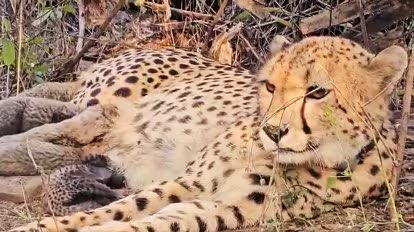Why Is It in News?
- At Kuno National Park (MP), Mukhi, the first India-born female cheetah, has given birth to five cubs.
- First instance of second-generation wild breeding in India post-reintroduction.
- Raises total cheetah population to 32, including 21 India-born.
- Termed a breakthrough by Union Environment Ministry for proving ecological adaptation.
Relevance
- GS-3 (Environment & Biodiversity)
Species reintroduction, ecological restoration. - GS-3 (Conservation Governance)
Role of NTCA, scientific protocols. - GS-3 (Science & Tech)
Animal telemetry, habitat modelling.

Project Cheetah
- Launched 2022 for reintroduction of cheetahs from Namibia & South Africa.
- Objective:
- Establish self-sustaining, genetically diverse cheetah metapopulations.
- Restore open forest–savannah landscapes.
- Managed by:
- NTCA
- WII
- State Forest Departments
Why Mukhi’s Birth Is Historically Significant
A. First India-born cheetah to reproduce
- Establishes evidence of successful biological integration of reintroduced cheetahs.
B. Proof of suitability of Indian habitats
- Indicates:
- Sufficient prey base
- Acceptable predator competition
- Healthy adaptation cycle
C. Wild reproduction despite early adversity
- Mukhi was:
- Born to Namibian cheetah Jwala (2023)
- Abandoned at birth
- Hand-raised by Kuno staff
- Later rewilded successfully
- Demonstrates adaptive success of human-assisted rearing + wild integration.
Population Update
- Total cheetahs: 32
- 29 in Kuno
- 3 in Gandhi Sagar Wildlife Sanctuary
- 21 are India-born → large F1 generation emerging.
Scientific and Conservation Significance
A. Genetic viability
- Second-generation births critical for:
- Genetic mixing
- Minimising founder-effect bottlenecks
- Stability of future populations
B. Behavioural adaptation
- Shows:
- Successful hunting skills
- Reproductive acceptance
- Habitat fidelity
C. Indicator of ecological restoration
- Cheetahs returning to Indian landscapes after 70+ years (extinct since 1952).
Challenges still present
- Mortality among translocated cheetahs.
- Kuno’s limited carrying capacity (approx. 20–21 adults).
- Need for multiple cheetah landscapes (Gandhi Sagar, Nauradehi, Mukundra Hills).
- Radio-collar issues.
- Potential human–wildlife conflict.
Way Forward
- Diversify release sites to prevent overcrowding in Kuno.
- Strengthen veterinary and monitoring teams.
- Improve prey base and grassland restoration.
- Scientific population management (genetic mapping, soft-release protocols).
- Community engagement to prevent conflict.



